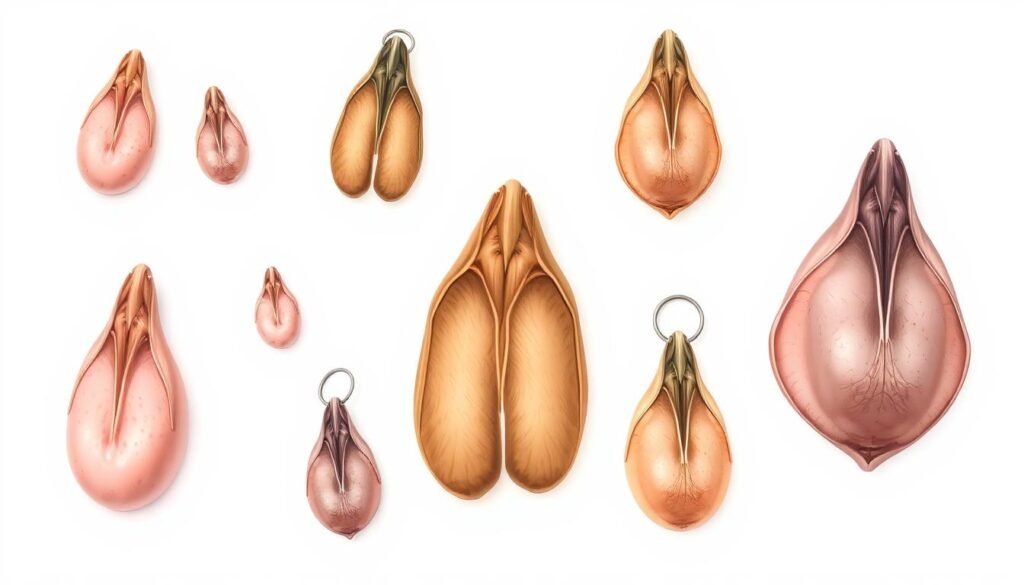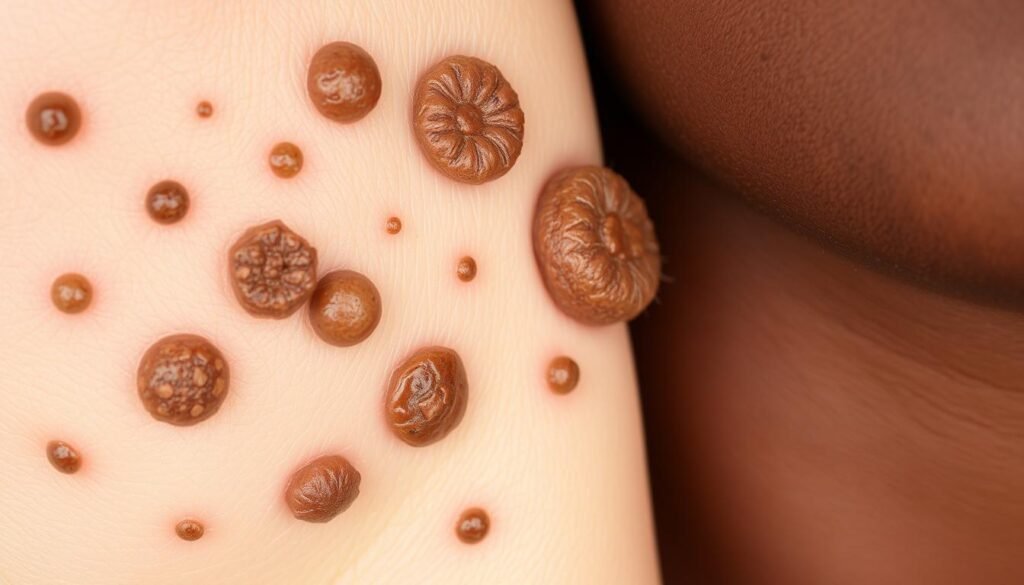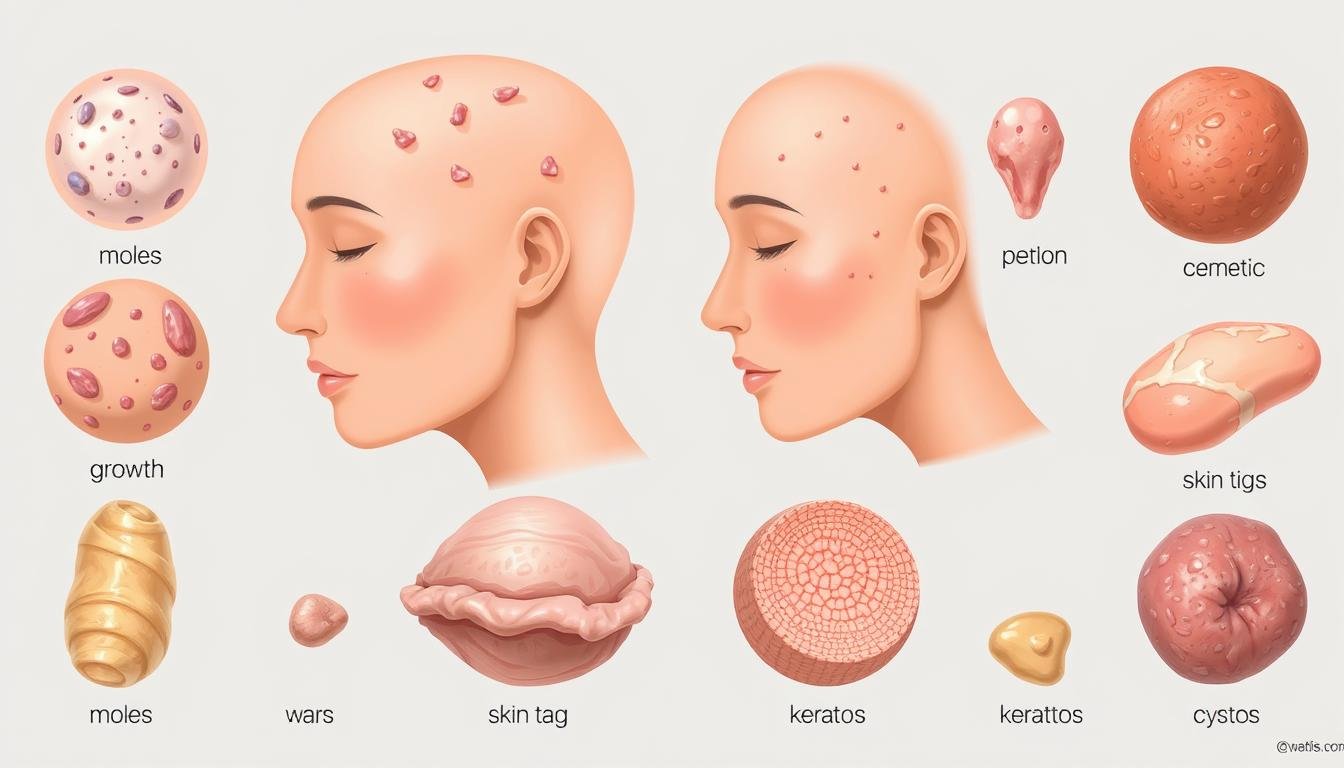Every mark on our skin tells a story. I remember the first time I noticed an unusual spot. It made me feel anxious. But learning about skin lesions can turn fear into knowledge, helping us take care of our skin.
Growths on skin are more common than many think. They range from harmless birthmarks to signs of health issues. Our guide will help you understand skin growths better, with confidence and clarity.
Skin lesions are spots that look different from the rest of your skin. They can be harmless or show signs of health problems. Up to 50% of people get moles, with most adults having 10 to 40 by age 20. Knowing about these growths can give us important health insights.
Key Takeaways
- Skin growths are usually harmless but need watching
- Most adults have between 10-40 moles by age 20
- Experts suggest checking your skin monthly
- Different growths can mean different health issues
- Seeing a doctor is key for unusual skin changes
Understanding Skin Growths and Their Impact on Health
Skin lumps and bumps are more common than most people think. Our bodies can develop various skin abnormalities throughout life. Each has unique characteristics and health implications. Knowing about these growths helps us keep our skin healthy and know when to seek medical help.
Skin growths fall into different types, each a unique skin condition. Let’s look at the main categories:
Different Categories of Skin Growths
- Primary lesions: Macules, papules, nodules, vesicles, pustules
- Secondary lesions: Atrophy, crust, erosion, ulcers
- Benign growths: Moles, skin tags, cysts
- Potentially cancerous growths: Atypical moles, unusual skin bumps
How Skin Growths Affect Daily Life
Skin abnormalities can affect our mental and physical health. Some skin lumps might cause:
- Self-consciousness about appearance
- Physical discomfort or irritation
- Potential limitations in clothing choices
- Emotional stress related to unexplained skin changes
Risk Factors for Developing Skin Growths
| Risk Factor | Impact on Skin Growths |
|---|---|
| Age | Increased likelihood of benign skin abnormalities |
| Skin Type | Darker skin more prone to certain growths like keloids |
| Genetics | Inherited predisposition to specific skin conditions |
| Sun Exposure | Higher risk of developing skin abnormalities |
“Knowledge is the first line of defense in managing skin health.” – Dermatology Experts
Remember, while most skin growths are harmless, any sudden or significant changes should be evaluated by a healthcare professional.
Birthmarks: Types and Characteristics
Birthmarks are unique skin marks that appear on newborns and young children. They can be small or large, and some are barely noticeable. Our guide explores the world of birthmarks, helping parents understand these common skin variations.
Interestingly, more than 10 percent of babies have some type of birthmark. Some of the most common types include:
| Birthmark Type | Characteristics | Prevalence |
|---|---|---|
| Hemangiomas | Red or purple raised marks | 1 in 20 newborns |
| Café-au-Lait Spots | Light brown patches | 30% of children by age 6 |
| Port Wine Stains | Permanent red or maroon marks | Less common |
Some birthmarks need medical attention. Children with multiple café-au-lait spots might have genetic conditions like neurofibromatosis. Larger congenital nevi (moles) can potentially develop into skin cancer later in life, making regular dermatological check-ups important.
Understanding your child’s birthmarks can help distinguish between harmless variations and possible health concerns.
Most birthmarks are harmless and may fade with time. For example, hemangiomas usually resolve by age 9, with 90% disappearing without treatment. But, some birthmarks like port-wine stains may need laser therapy or ongoing medical evaluation.
Moles and Melanocytic Growths
Skin abnormalities like moles are fascinating growths that play a significant role in our dermatological health. These pigmented spots are more than just visual markers on our skin – they represent complex cellular developments that require careful understanding and monitoring.
Our bodies typically develop between 10 to 45 moles during childhood and teenage years. These growths on skin occur when melanocytes cluster together instead of spreading evenly across the skin surface.
Congenital Nevi
Congenital nevi are moles present at birth, occurring in approximately 1% to 2% of newborns. Their characteristics include:
- Can vary in size from small to giant
- Lifetime melanoma risk ranges from 0% to 5% for small to medium nevi
- Larger congenital nevi may have up to 10-12% melanoma transformation risk
Atypical Dysplastic Nevi
Atypical or dysplastic nevi represent unique skin abnormalities characterized by irregular shapes and genetic components. Key insights include:
- Often associated with Familial Atypical Mole and Melanoma (FAMM) syndrome
- Individuals might have 50-100 atypical moles
- Considered a risk factor for melanoma development
Warning Signs of Dangerous Moles
“Early detection can save lives when it comes to skin abnormalities.” – Dermatology Research Institute
We recommend using the ABCDE method to assess potentially dangerous moles:
| Criteria | Description |
|---|---|
| Asymmetry | One half doesn’t match the other |
| Border | Irregular, jagged, or blurred edges |
| Color | Multiple colors or uneven pigmentation |
| Diameter | Larger than 6mm (pencil eraser size) |
| Evolving | Changes in size, shape, or color over time |
Stay vigilant about growths on skin by performing monthly self-examinations and consulting healthcare professionals if you notice any concerning changes.
Common Types of Growths on Skin
Our skin can grow different types of growths over time. Many people worry about these bumps, but most are not harmful. Knowing about these growths can ease your worries and help you understand their health signs.
- Skin tags: Commonly found in 25% to 50% of adults, mainly in those who are overweight or diabetic
- Warts: Caused by human papillomavirus (HPV), affecting over 10% of the population
- Skin cysts: Generally benign, occurring in up to 5% of individuals
Each skin growth has its own traits and meanings. Skin tags are soft, small, and flesh-colored. They often show up in places where skin rubs together, like the neck or armpits. Warts are rough, raised bumps that can spread when you touch them.
“Most skin growths are benign, but understanding their nature is key to maintaining skin health.” – Dermatology Research Institute
Skin cysts are sacs filled with fluid or semi-solid stuff. They’re usually not a problem, but they can get infected or need a doctor’s visit.
| Skin Growth Type | Prevalence | Risk Factors |
|---|---|---|
| Skin Tags | 25-50% of adults | Obesity, diabetes |
| Warts | 10% of population | Viral infection |
| Skin Cysts | 5% of population | Genetic predisposition |
Even though most skin growths are safe, watch for any changes. See a dermatologist if your growths grow fast, change color, or look different.
Skin Tags (Acrochordons): Causes and Treatment
Skin tags are common growths on skin that affect nearly half of all adults. These small, soft tissue developments can appear anywhere on the body. They create cosmetic concerns for many individuals.

Our medical research shows interesting facts about these benign skin growths. About 50-60% of adults will get at least one skin tag in their lifetime. The chance of getting one increases after age 40.
Risk Factors for Developing Skin Tags
- Obesity and excess body weight
- Diabetes
- Pregnancy hormonal changes
- Genetic predisposition
- Age over 40
Treatment Options Available
There are many ways to manage skin tags. Patients have several professional medical options:
| Treatment Method | Procedure Details | Recovery Time |
|---|---|---|
| Cryotherapy | Freezing with liquid nitrogen | 1-2 weeks |
| Surgical Excision | Removal using surgical scissors | 7-10 days |
| Hyfrecation | Electrical energy burning | 5-7 days |
Prevention Methods
To prevent skin tags, keep a healthy lifestyle. Strategic approaches can minimize their development:
- Maintain healthy body weight
- Regular exercise
- Balanced nutrition
- Manage underlying health conditions
Skin tags are typically harmless and do not require immediate medical intervention unless they cause discomfort or cosmetic concerns.
We suggest talking to a dermatology professional for personalized advice on skin tags and treatment options.
Sebaceous Cysts and Epidermoid Tumors
Skin cysts are common growths that can appear on different parts of the body. Epidermoid cysts, also known as skin lumps, are small, round bumps that look white or yellow. They often show up on the face, neck, and trunk.
Our medical experts say epidermoid cysts are usually harmless and grow slowly. Most people with these cysts don’t need to see a doctor right away. But, it’s important to know about them for good skin health.
- Typically occur in individuals past puberty
- Most common age range: 20 to 60 years old
- More prevalent in individuals assigned male at birth
- Size range: 0.25 to 2 inches in diameter
While most skin cysts don’t cause problems, some can lead to issues in 1-5% of cases. These might include inflammation, infection, or very rare cases of cancer. Signs that could mean trouble include:
- Rapid growth
- Diameter larger than 5 centimeters
- Persistent pain or discomfort
- Changes in appearance or texture
“Understanding your skin’s health is the first step in proactive medical care.” – Dermatology Research Institute
Genetic conditions like Gardner syndrome might make you more likely to get these skin lumps. We suggest watching any unusual skin growths. If you see big changes or feel pain, talk to a healthcare professional.
Keratosis Pilaris: Understanding the Condition
Keratosis pilaris is a common skin condition found in many people. It’s also known as “chicken skin.” This condition causes small, rough bumps on different parts of the body. Our guide will help you understand and manage this skin issue.
About 50-80% of teens and young adults have this condition. The bumps often show up on the upper arms, thighs, cheeks, and buttocks. They look like goosebumps.
Symptoms and Characteristics
- Tiny, rough bumps resembling goosebumps
- Dry, itchy patches, more common in winter
- Reddish or white bump clusters
- Variations in bump size and texture
Diagnostic Insights
Dermatologists can spot keratosis pilaris just by looking. It doesn’t need special tests. Doctors will check the skin’s texture and where the bumps are.
| Age Group | Prevalence | Symptom Intensity |
|---|---|---|
| Children | 40% | Mild to Moderate |
| Adolescents | 70% | Moderate |
| Adults | 40% | Mild to Reducing |
Treatment Approaches
There’s no cure, but treatments can help. We suggest:
- Moisturizers with urea or alpha hydroxy acids
- Gentle exfoliation
- Prescription creams with salicylic acid
- Keeping skin hydrated
“Most patients see noticeable improvements within 4-6 weeks of consistent treatment,” says dermatology experts.
Knowing it often gets better with age can be comforting. Symptoms usually lessen by mid-20s. Many cases clear up by age 30.
Lipomas: Soft Tissue Tumors
Lipomas are interesting skin lumps that are the most common soft tissue tumors in adults. They grow slowly and feel soft and movable under the skin. Unlike serious skin growths, lipomas are usually harmless and don’t hurt much.
“Most lipomas are small, painless, and require no immediate medical intervention.” – Dermatology Research Institute
Our medical team knows a lot about lipomas:
- They usually show up between ages 40-60
- Men get them a bit more often
- They are usually less than 2 inches wide
- They often appear on the upper trunk, head, neck, and shoulders
It’s important to know when to see a doctor. While most lipomas are not a problem, some situations need a doctor’s check:
- Lipomas bigger than 5 cm
- Growth that hurts or feels uncomfortable
- Changes in size or look that happen fast
- Many lipomas showing up at once
Doctors use physical checks and imaging like MRI to figure out what these lumps are.
| Lipoma Characteristic | Details |
|---|---|
| Composition | Fatty tissue in a thin fibrous capsule |
| Surgical Removal | Recommended for big or painful lipomas |
| Recurrence Rate | Low, it’s rare for them to come back after being removed |
Remember, while lipomas are usually safe, seeing a doctor helps make sure you’re okay.
Dermatofibromas and Their Management
Dermatofibromas are interesting skin bumps that often confuse both patients and doctors. They are small, firm growths that can show up on different parts of the body. These growths are usually harmless.
Our dermatology experts know a lot about these growths. They are small, firm bumps that are about 0.5 to 1.5 centimeters in size. They have unique looks that catch the eye.
Identifying Characteristics
Dermatofibromas have some key features that help identify them:
- They can be tan to reddish-brown in color
- They feel firm and have a “dimple sign” when pressed
- They are often found on arms, legs, and the trunk
- They are usually painless but can sometimes cause mild irritation
Available Treatment Options
Our treatment options depend on several factors:
- Watching stable, painless growths
- Removing them surgically for cosmetic reasons or discomfort
- Trying cryotherapy or laser removal as alternatives
*”Not all skin growths need immediate action, but it’s always wise to get a professional check-up.”*
We tell patients to watch for any changes in their dermatofibromas. Even though they are usually harmless, any unusual changes should be checked by a doctor.
Our team can help you understand these skin bumps. We can also find the best way to manage them based on your needs.
Seborrheic Keratosis: Age-Related Growths

Seborrheic keratosis is a common skin issue that comes with age. These growths look like waxy, slightly raised patches. They can be light tan to dark brown in color. Dermatologists see them as a normal part of aging
Characteristics of Seborrheic Keratosis:
- Typically appear after age 40
- Can grow up to 1 inch in width
- Often found on chest, back, and shoulders
- Vary in texture from smooth to rough
About 83% of people will get at least one seborrheic keratosis by age 60. People with lighter skin and a family history are more likely to get them.
| Age Group | Prevalence |
|---|---|
| 40-50 years | 30% occurrence |
| 50-60 years | 55% occurrence |
| Over 65 years | 90% occurrence |
“Most skin growths are harmless, but always consult a dermatologist for professional evaluation.” – Skin Health Experts
Even though these growths are usually harmless, it’s wise to get them checked by a doctor. Treatments like cryotherapy and electrosurgery can be very effective.
Our medical team knows how worrying skin changes can be. We suggest regular skin check-ups, mainly for those who spend a lot of time in the sun or are over 40.
Molluscum Contagiosum: Viral Skin Growths
Molluscum contagiosum is a common viral skin infection. It creates distinctive skin bumps, mainly in children and adults with weak immune systems. This condition is highly contagious and spreads through direct contact and shared items.
Our guide covers the key aspects of this viral skin condition. It helps you understand how it spreads, its symptoms, and how to manage it.
Transmission Pathways
The virus spreads in several ways:
- Direct skin-to-skin contact
- Sharing personal items like towels and clothing
- Contact with contaminated surfaces
- Sexual transmission in adults
Demographic Characteristics
Molluscum contagiosum mainly affects certain groups:
| Age Group | Infection Characteristics |
|---|---|
| Children (1-10 years) | Most common infection group |
| Immune-compromised Individuals | Higher susceptibility |
| Athletes | Increased transmission risk |
Treatment Options
Our medical experts suggest several treatments:
- Watchful waiting for natural resolution
- Topical medications
- Cryotherapy for persistent skin bumps
- Gentle removal techniques
Prevention is key: Practice good hygiene and avoid sharing personal items to minimize transmission risks.
Understanding molluscum contagiosum empowers individuals to manage this common viral skin condition effectively.
When to Seek Medical Attention
Knowing when to get help for skin problems is key for catching health issues early. About 1 in 5 Americans will get skin cancer. Spotting warning signs is vital for good health.
Our dermatology team says watch out for certain skin lesions that might need a doctor’s check. Look out for:
- Wounds that won’t heal
- New skin growths
- Big changes in moles or growths
- Odd color or texture changes
Keep an eye on your skin. A full skin check by a can spot 95% of skin cancers early. If you see any skin issues that worry you, like:
- Fast growth
- Unusual shape
- Color changes
- Itching that won’t stop
- Bleeding without reason
Early spotting of skin problems can greatly help treatment and lower health risks.
“Your skin is your body’s largest protective organ. Treat it with care and attention.” – Dermatology Experts
Treatment Options and Medical Procedures
Patients facing skin lumps and bumps have many treatment options. Our medical team knows each growth needs a unique plan. This plan is based on the growth’s specific traits.
Choosing the right treatment depends on several factors. These include the type, size, and where the bump is. Today’s dermatology offers both surgery and non-surgery options for different skin issues.
Surgical Removal Techniques
Surgery is a precise way to remove skin lumps. Our methods include:
- Excisional surgery for complete removal
- Cryosurgery using extreme cold temperatures
- Laser ablation for targeted treatment
- Electrodesiccation for smaller growths
The Mayo Clinic suggests that Mohs surgery can cure over 99% of some skin cancers.
Non-Surgical Treatment Options
For those who prefer less invasive methods, we have non-surgical options:
- Topical medications
- Photodynamic therapy
- Chemical treatments
- Specialized laser therapies
“Every skin growth is unique, and so should be its treatment approach.” – Dermatology Specialists
We make sure each patient gets the best treatment for their skin bumps. We focus on both treating the issue well and making sure the patient is comfortable.
Prevention and Skin Care Tips
To keep your skin safe from rashes and other issues, follow a detailed care plan. Our dermatology experts suggest using certain methods to protect your skin’s health and look.
Protecting your skin from the sun is key. Skin protection strategies help a lot in avoiding damage from UV rays.
- Apply broad-spectrum sunscreen with SPF 30 or higher
- Reapply sunscreen every two hours during sun exposure
- Wear protective clothing and wide-brimmed hats
- Seek shade during peak sunlight hours
“Prevention is always better than cure when it comes to skin health.” – Dermatology Experts
What you do every day affects your skin. Eating foods full of antioxidants can slow down skin aging by 35%. Drinking plenty of water, managing stress, and sticking to a skincare routine are key to avoiding skin problems.
| Prevention Strategy | Impact |
|---|---|
| Daily Moisturizing | Decreases dry skin likelihood by 40% |
| Stress Management | Can improve skin conditions by 25% |
| Antioxidant-Rich Diet | Reduces skin aging up to 35% |
Regular skin self-examinations are key for catching problems early. Look out for changes in moles using the ABCDE rule: Asymmetry, Border irregularity, Color changes, Diameter, and Evolving characteristics.
Conclusion
Understanding growths on skin is key. Our dermatology team knows that skin lesions can be harmless or serious. About 60% of skin cancers are basal cell carcinomas, and melanoma is rare but deadly.
Regular skin checks are important. They help catch problems early. Our team uses a detailed approach to care for your skin.
In Florida, you can find our dermatology services in many places. This includes Orlando, Clermont, and more. Call us at +1(352) 565-7575 for a skin check.
Your skin health reflects your overall health. Stay informed and proactive. This way, your skin stays healthy and vibrant for years.




